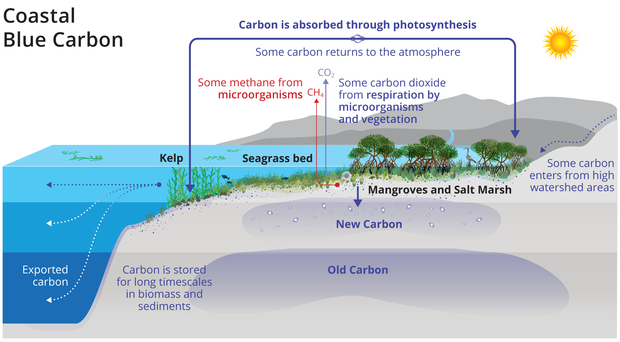
Blue-Carbon Projects are a type of carbon sequestration initiative that focuses on preserving, restoring, or enhancing marine ecosystems such as mangroves, salt marshes, kelp forests, coral reefs, and other coastal habitats. These projects aim to capture and store atmospheric CO2 in the form of organic matter within these underwater environments.
Key features of Blue-Carbon Projects:
- Marine ecosystem conservation: Protecting and restoring marine ecosystems that are rich in carbon-storing vegetation such as mangroves, salt marshes, or seagrasses.
- Carbon sequestration through photosynthesis: Marine plants absorb CO2 from the atmosphere during photosynthesis, storing it within their biomass and sediments.
- Soil formation and sedimentation: As marine plants grow and die, they contribute to soil formation in coastal areas, which can store significant amounts of carbon for centuries or even millennia.
- Reduced greenhouse gas emissions: By preserving these ecosystems, Blue-Carbon Projects help maintain the natural processes that regulate CO2 levels in the atmosphere.
Benefits of Blue-Carbon Projects:
- Climate change mitigation: These projects contribute to reducing atmospheric CO2 concentrations by sequestering carbon within marine ecosystems.
- Ecosystem services preservation: Protecting and restoring these coastal habitats maintains essential ecosystem functions such as shoreline stabilization, fisheries support, water filtration, and biodiversity conservation.
- Coastal resilience enhancement: Preserving or enhancing the health of these ecosystems can help protect communities from climate-related hazards like storm surges, erosion, and sea-level rise.
Examples of successful Blue-Carbon Projects:
- The Mangrove Forest Restoration Project in Indonesia, which has restored over 100 hectares (247 acres) of mangroves since its inception.
- The Kelp Forest Conservation Program in California, USA, aimed at protecting these underwater ecosystems and their associated carbon sequestration potential.
- The Coral Reef Trust's Blue Carbon Initiative in the Maldives, which promotes sustainable fishing practices while preserving coral reefs that store significant amounts of CO2.
Challenges and limitations:
- Monitoring and verification: Accurately measuring the carbon sequestered within these ecosystems can be complex due to factors like tidal cycles, water currents, or changes in vegetation density.
- Land-use conflicts: Coastal areas often face competing demands for land use (e.g., urbanization, agriculture), which may compromise ecosystem conservation efforts.
- Climate-related hazards: Rising sea levels and increased storm frequency can threaten the very existence of these ecosystems.
Despite these challenges, Blue-Carbon Projects offer a promising approach to climate change mitigation by leveraging the natural carbon sequestration potential of marine ecosystems.

